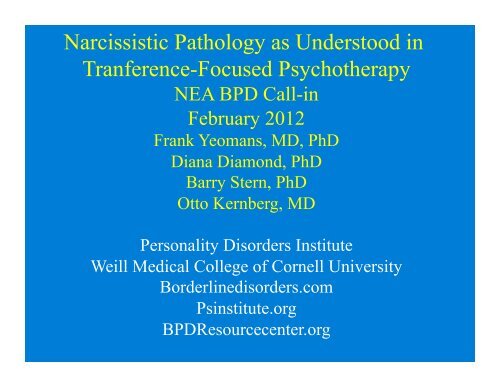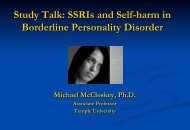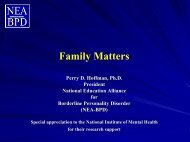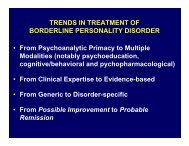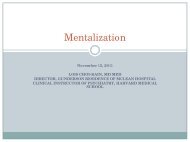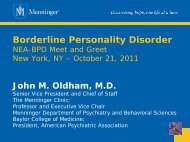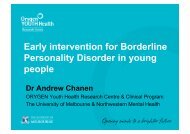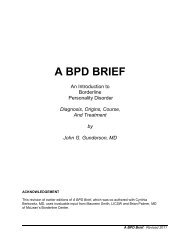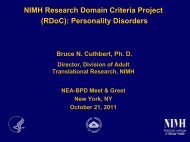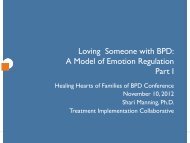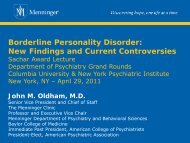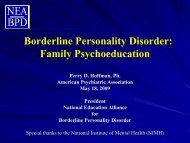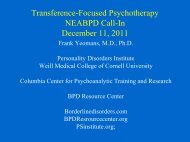February 12, 2012 â Dr. Frank Yeomans - Borderline Personality ...
February 12, 2012 â Dr. Frank Yeomans - Borderline Personality ...
February 12, 2012 â Dr. Frank Yeomans - Borderline Personality ...
Create successful ePaper yourself
Turn your PDF publications into a flip-book with our unique Google optimized e-Paper software.
Narcissistic Pathology as Understood in<br />
Tranference-Focused Psychotherapy<br />
NEA BPD Call-in<br />
<strong>February</strong> 20<strong>12</strong><br />
<strong>Frank</strong> <strong>Yeomans</strong>, MD, PhD<br />
Diana Diamond, PhD<br />
Barry Stern, PhD<br />
Otto Kernberg, MD<br />
<strong>Personality</strong> Disorders Institute<br />
Weill Medical College of Cornell University<br />
<strong>Borderline</strong>disorders.com<br />
Psinstitute.org<br />
BPDResourcecenter.org
Readings - 1<br />
• Kernberg OF (1984). Severe <strong>Personality</strong><br />
Disorders. New Haven, Yale University<br />
Press, chapters 11 to 14.<br />
• Kernberg OF (2004). Aggressivity,<br />
Narcissism & Self-destructiveness in the<br />
Psychotherapeutic Relationship. New<br />
Haven: Yale University Press.<br />
• Kernberg PF. Narcissistic <strong>Personality</strong><br />
Disorder in Childhood. Psychiatric Clinics<br />
of North America. XII, 3, September 1989,<br />
671-694.
Readings - 2<br />
• Diamond D, <strong>Yeomans</strong> FE, and Levy<br />
K Psychodynamic Psychotherapy for Narcissistic<br />
<strong>Personality</strong> Disorder. The Handbook of<br />
Narcissism and Narcissistic <strong>Personality</strong> Disorder:<br />
Theoretical Approaches, Empirical Findings, and<br />
Treatment, Eds. Keith Campbell and Josh Miller,<br />
New York: Wiley, 2011<br />
• Stern BL, <strong>Yeomans</strong> FE, Diamond D, & Kernberg<br />
OF. (in press). Transference-Focused<br />
Psychotherapy (TFP) for Narcissistic <strong>Personality</strong><br />
Disorder. In, Treating Pathological Narcissism,<br />
Ogrodniczuk, J., (Ed.). American Psychiatric<br />
Press: Washington, DC, 2011
IPDE Criteria for NPD<br />
1. Grandiose sense of self importance<br />
2. Fantasies of success/power<br />
3. Believes self to be special and unique<br />
4. Requires excessive admiration<br />
5. Entitlement<br />
6. Interpersonally exploitative<br />
7. Lacks empathy<br />
8. Envious of others<br />
9. Shows arrogant, haughty behaviors/attitudes
NPD/BPD: How are they related<br />
• NPD and BPD share same level of structural<br />
intrapsychic organization<br />
– identity disturbances<br />
• The Grandiose Self characterizes NPD:<br />
– A condensation of everything that seems ideal and<br />
good, with the exclusion of anything negative –<br />
– It is a compensatory structure that is superimposed<br />
on fragmented internal world to provide a<br />
semblance of integration and stability to cover<br />
feelings of inadequacy and emptiness
Narcissism: multiple meanings<br />
• Developmental phases/mental states: primary<br />
narcissism and secondary narcissism<br />
• A question of self esteem and how to manage<br />
it<br />
• A description of the state and quality of an<br />
individual’s object relations (capacity to<br />
invest in relations with others)
Maintaining self-esteem - an internal affair<br />
• The individual’s relation to the ego ideal:<br />
internalized representations… fantasies…<br />
• The difference between the ego ideal and<br />
the real self (as perceived): how to manage<br />
the gap<br />
• The relation of this to BPD self-loathing/<br />
self-hatred
Maintaining self-esteem – cont’d<br />
• The gap can be in relation to self-representations:<br />
“I’d be happy with myself if I could be or do x, y,<br />
z….” “I loathe myself because I’m not what I<br />
think I should be.”<br />
• It can also be in relation to object<br />
representations… projections on others: “I’d be<br />
happy with myself if I lived up to his/her<br />
expectations of me.” “I loathe myself if I don’t.”<br />
• Therefore, the importance of<br />
– Distinguishing between self and other<br />
– Achieving integrated, realistic internal representations<br />
of self and other in one’s mind
Another psychological issue at play<br />
• To experience and express one’s own<br />
aggression in a healthy way<br />
• The impact of aggression on objet relations.<br />
• Why talk about aggression<br />
– A basic human affect/drive<br />
– It affects interpersonal relations<br />
– It can be experienced as envy in narcissism<br />
• What do we mean by aggression
Among other things, Self-acceptance<br />
includes:<br />
• Integrating one’s aggressive feelings in a<br />
healthy way<br />
• Managing the impact of aggression on<br />
object relations.
What is healthy narcissism<br />
• Appreciating one’s self with positive regard<br />
and loving feelings. This involves accurate<br />
appraisal of:<br />
– Success, creativity, accomplishment, ambition<br />
– Interpersonal relations, family, friends<br />
– The ability to satisfy one’s desires/drives<br />
– The ability to live in accord with one’s moral<br />
values and principles
What is infantile narcissism<br />
• The primitive infantile self passes through a<br />
narcissism based on gratification/satisfaction of<br />
needs, including the need to connect, to engage<br />
with the other<br />
• The adult with infantile narcissism:<br />
– Insatiable neediness<br />
– Incessant demandingness<br />
– But… the other exists for these individuals and they can<br />
tolerate dependency<br />
• Infantile narcissism is frequent in borderline<br />
patients
What is pathological narcissism - 1<br />
• A specific personality disorder<br />
• The libidinal investing of a pathological self<br />
structure that is organized around a<br />
pathological grandiose self – which is a<br />
rigid self structure that serves as a defense<br />
– It involves idealized representations of self and<br />
other<br />
– It excludes the possibility of engaging in<br />
relations at a deep level – there is a chronic<br />
devaluing of others – “I don’t need anyone; I<br />
have/am everything that I need.”
Pathological narcissism - 2<br />
• The denial of dependency and refuge into<br />
omnipotence (which can lead to increasing<br />
isolation from the real world, since contact<br />
with others challenges that)<br />
• Intense envy; the solution is to not need the<br />
other.<br />
• The wish to be loved is transformed into the<br />
need to be admired.<br />
• Intense fear of being humiliated<br />
• Use others to satisfy one’s own needs
Narcissism: Two Sides<br />
• Thick skinned vs. Thin skinned (Rosenfeld)
A Diagnostic System for Narcissism within<br />
<strong>Borderline</strong> <strong>Personality</strong> Organization<br />
Fundamental Characteristics<br />
• Identity Diffusion vs. Integration (an<br />
internal sense of continuity)<br />
• No integrated concept of self<br />
– However, the narcissist can demonstrate a<br />
facsimile of integration<br />
• No integrated concept of others<br />
• Primitive defenses<br />
• Variable reality testing<br />
– Unrealistic sense of grandeur
BPO: consequences and clinical<br />
implications<br />
• Non-specific weakness of the ego: poor impulse<br />
control and low anxiety tolerance<br />
• Unstable and disturbed interpersonal relations.<br />
Narcissists reject dependency and eliminate<br />
relations with others<br />
• A lack of engagement in work and love life.<br />
Severe narcissism: exploitation and the possibility<br />
of criminal acts. Feeling above rules and law.<br />
• Sexual Pathology (total inhibition or chaotic sex<br />
life)
BPO: consequences and clinical<br />
implications … (cont’d)<br />
• Pathology of moral functioning<br />
• The destruction of time – especially in<br />
narcissists<br />
• With sharp midlife decline in functioning<br />
• Difficulty engaging the patient<br />
– Fragility of defenses<br />
– A devaluing Transference/countertransference
Treatment:<br />
Reminder of the Theory that guides<br />
the Treatment<br />
• The concept of split internal psychological<br />
structure constitutes the principal source of<br />
identity diffusion and underlies borderline<br />
symptomatology
<strong>Borderline</strong> Patient’s<br />
Internal World<br />
-S1<br />
-a1<br />
S = Self-Representation<br />
O = Object - Representation<br />
-O1<br />
a = Affect<br />
Examples<br />
S1 = Meek, abused figure<br />
O1 = Harsh authority figure<br />
a 1 = Fear<br />
S2 = Childish-dependent figure<br />
O2 = Ideal, giving figure<br />
a2 = Love<br />
S3 = Powerful, controlling figure<br />
O3 = Weak, Slave-like figure<br />
a3 = Wrath<br />
+S2<br />
+a2<br />
+O2<br />
-S3<br />
.<br />
-a3<br />
-O3<br />
Etc.
Narcissistic Psychopathology<br />
The Pathological Grandiose Self<br />
Self Representation<br />
Object Representation<br />
Contempt, Derision,<br />
Scorn<br />
(Fear, Suspicion)<br />
Grandiose<br />
(Self-sufficient)<br />
Depreciated, Devalued<br />
(Needy, Hostile, Envious)
Narcissistic Psychopathology<br />
The Pathological Grandiose Self<br />
The Pathological Grandiose Self wards off a selfexperience<br />
of:<br />
- inferiority<br />
- aggression and hatred<br />
- envy<br />
- rejection<br />
- humiliation<br />
- incompetence
Narcissistic Object Relations Dyad:<br />
Oscillation<br />
Self-Rep<br />
Object Rep<br />
Contempt, Derision<br />
Grandiose<br />
Self-sufficient<br />
Needs nothing<br />
Depreciated<br />
Devalued<br />
Nothing to offer<br />
Depreciated<br />
Devalued<br />
Nothing to offer<br />
Fear, Suspicion<br />
Arrogant<br />
Independent<br />
Superior
One Narcissistic Object Relations Dyad<br />
Defending Against Another Dyad<br />
Surface Dyad<br />
Affect is Contempt<br />
Grandiose<br />
Self-sufficient<br />
Negatively valenced,<br />
“persecutory” dyad<br />
Depreciated<br />
Devalued object<br />
Defended-against<br />
Dyad<br />
Affect is Longing, Love<br />
Dependent, perfectly<br />
nurtured self<br />
Positively-valenced,<br />
“idealized” dyad<br />
Admiring, caring,<br />
Loving object
The Goal: Normal Organization
Transference-Focused Psychotherapy (TFP) with<br />
Narcissistic Pathology<br />
• The goal of TFP with narcissistic pathology:<br />
neutralization and dismantling of the Pathological<br />
Grandiose Self through the integration of the parts<br />
of the self that are split off<br />
• This is complicated by the tenaciousness of the<br />
defensive process reinforcing the Pathological<br />
Grandiose Self and the tremendous sensitivity to<br />
humiliation, shame, inferiority, submission
Obstacles to TFP with Narcissistic Patients<br />
Treatment Contract<br />
• Patient’s defensive grandiosity often leads to<br />
- A retreat from life’s challenges<br />
- Feeling exempt from demands or obligations<br />
- A cavalier attitude toward treatment (why<br />
submit)<br />
• Importance of addressing secondary gain<br />
- Patient may depend on social services or<br />
family<br />
- “Can not” vs. “will not” function<br />
• Managing suicidality / self-injury
Technical Aspects:<br />
Adapt the therapy to the level of the<br />
pathology<br />
• The more serious the case, the more strict<br />
and fully developed is the frame<br />
• The more serious the case, the more<br />
interpretations will address the primary<br />
nature of the aggression (versus aggression<br />
as a defense against libidinal longings)<br />
• The more brittle the case, the more<br />
flexibility in the technique
Principle Obstacle to Treatment with Narcissistic<br />
Patients<br />
• The alternative to the grandiose self<br />
is a sense of annihilation
Obstacles to TFP with Narcissistic Patients:<br />
Interpretation<br />
• The content of interpretation – brings the patient<br />
into contact with that which he desperately needs<br />
to project and therefore is a threat to the<br />
Pathological Grandiose Self (resulting rage,<br />
omnipotent control)<br />
• Interpretation can be seen as an enactment of a<br />
cruel authority forcing the patient into a<br />
humiliating submission
An attempt to address the obstacles:<br />
Therapist-centered interpretations<br />
Exploring the devalued object as it is perceived<br />
in the therapist may allow the patient to begin<br />
to reflect on this object without the<br />
catastrophic reaction that accompanies seeing<br />
it as part of the self<br />
This can help the patient observe and reflect on<br />
the devalued, dependent object – and on the<br />
associated aggression, as a step to bringing<br />
what is projected into their field of reflection<br />
Example
As Therapy Progresses…<br />
The patient gradually experiences a conflict<br />
between his refuge into the false grandiose<br />
self and some awareness of “reality”<br />
The therapist often becomes the representative<br />
of reality; he/she becomes a bridge to a real<br />
alternative to the “exquisite” isolation<br />
The therapist must therefore have acute<br />
empathy for the pain and sense of<br />
humiliation involved in this process
A Key Role of Reflective Functioning in<br />
Working with Narcissistic Patients<br />
Increasing RF – the capacity to reflect on his/<br />
her mind and that of others - helps the<br />
patient see that the grandiose self is one<br />
mental state among others (which are<br />
difficult to bear).<br />
The patient may come to realize that the<br />
grandiose self is at the price of a real<br />
relation – which the therapist offers, within<br />
the frame


